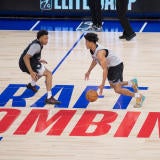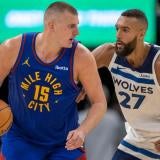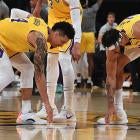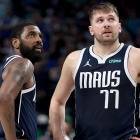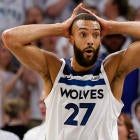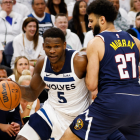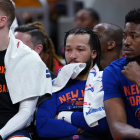LeBron James doesn't exactly have weaknesses, but the closest he comes is his shooting. For his career, he has made a relatively pedestrian 34.4 percent of his 3-point attempts, and even in a return to MVP candidacy this season, he is only up to 35.1 percent. James can shoot, but he isn't exactly Stephen Curry.
Well, most of the time anyway.
In Tuesday's 120-107 over the Philadelphia 76ers, James pulled up from Curry range and nailed a jumper from the "R" in the Lakers logo. His teammates were so impressed by the feat that they had to go over to the logo afterward and inspect it, just to be sure.
The guys had to inspect that spot after LeBron drained it from the logo 🤯😂
— Los Angeles Lakers (@Lakers) March 4, 2020
(📺: @SpectrumSN ) pic.twitter.com/AU7LdpUsco
While the shot looks remarkable in a vacuum, it speaks to a larger trend in James' game. He has been extending his range for years now, and the statistics prove that. Just consider his numbers on shots at least 28 feet from the basket.
| Season | Shots made (28+ feet) | Shots attempted (28+ feet) |
|---|---|---|
2019-20 | 19 | 50 |
2018-19 | 16 | 48 |
2017-18 | 23 | 44 |
2016-17 | 11 | 35 |
2015-16 | 6 | 14 |
Likely as an intentional response to players like Curry and Damian Lillard, James has made a concerted effort to take more long-range 3-point attempts. The function in doing so is obvious. No defender would dare leave James alone right behind the arc considering the threat he poses as a driver, so in order to actually generate space to shoot, he needed to move farther and farther behind the line.
That plan has largely worked. Given his somewhat inconsistent mechanics and footwork, James has a far easier time maintaining consistency in his shot motion when he is open. While the notion that players hit more of their shots when they are open might seem obvious, it is particularly important for players like James who need to take more drastic steps to actually get open. Over the past five years, he has never shot below 37.2 percent on wide-open 3-pointers. This season, he is shooting only 22.2 percent on 3-pointers the NBA considers tightly covered. Moving farther back has made James a far more dangerous shooting threat.
Yes, that creates opportunities for moments like these, in which his teammates can do little but stare in awe at their superstar leader, but it also goes a long way in properly spacing an offense that usually plays with two big men and diversifying his own game enough to keep him in the MVP conversation at the age of 35. James has perhaps done more than any player in NBA history to maintain peak performance into what is, athletically speaking, old age, and his shooting has become one of the most important elements of that process.








